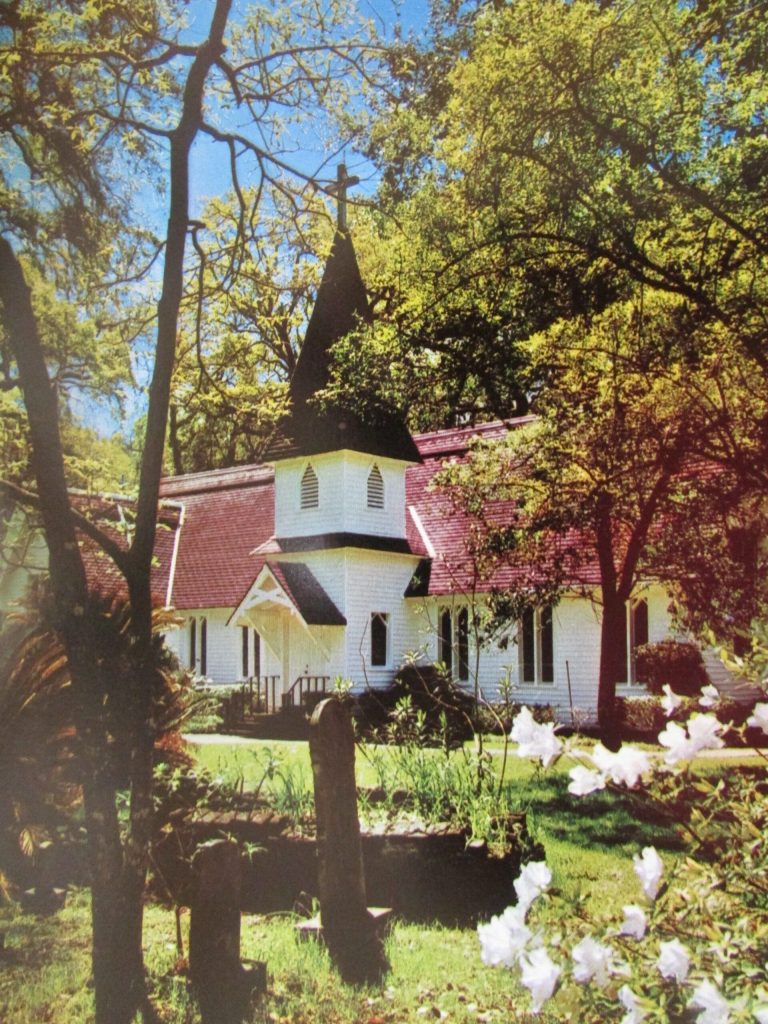Using the Home Town Advantage
Published 12:33 pm Sunday, September 1, 2024
|
Getting your Trinity Audio player ready...
|
No story about the Golden Isles would be complete without including St. Simon’s Island. Today, our journey will take us to this largest of the barrier islands. We will explore its most interesting past, which includes one of the bloodiest battles of the pre-Revolutionary War time, as well as a haunted church.
Located just across the fabled Marshes of Glynn, St. Simons history goes back a far piece, all the way to the early arrival of the Franciscan priests who came over to the New World with Fernando De Soto. His “job” was to explore our area which later became known as the Southeastern United States. From the writings of the priests, the first mass that was celebrated on St. Simons was in 1540.
It was also written in several of the priests’ diaries, that these early missionaries planted seedling live oaks on St. Simons. Later in history, when the quick sand on the island made it impossible to build a foundation, it was necessary to use pilings made from the branches of these live oaks to shore up the tabby buildings.
Trending
Growing in profusion, the wood from these stately live oaks, was also used to construct the keel and the sides of our most famous Revolutionary War ship: the “USS Constitution”, better known by its nickname: “Old Ironsides”. This name was quite accurate, for when cannon balls would hit the sides of the ship, they would just bounce right off. Today, she sets, strong and sturdy in Boston Harbor.
Perhaps the most important historical happening on St. Simons Island was the Battle at Bloody Marsh. The story starts when General James Oglethorpe came to America and founded the colony of Georgia. It might have been short lived had it not been for a deadly confrontation in 1742, between an invading Spanish army and a relatively small band of English settlers.
This all started a few years earlier, when a Spanish warship stopped the British ship, “Rebecca”, that was commanded by Captain Robert Jenkins. When Jenkins refused to allow the Spanish to search his vessel, a Spanish sailor cut off his ear! This incident was the spark that started an already brewing conflict between the British and Spanish. The battle was given the unusual name: The War of Jenkins’s Ear.
By 1740, the fighting had spread to the North American continent when a large Spanish force invaded Georgia. General Oglethorpe quickly gathered as many troops as he could from among the small farms and plantations around Savannah and hurried them south to beat back the invasion.
Under the leadership of Lieutenant Nobel Jones, one of Oglethorpe’s most trusted soldiers, the settlers defeated the Spanish, forcing them to return to their fort at St. Augustine. Against all odds, these settlers had managed to preserve their new Georgia homes.
The Spanish did not take this defeat lightly and two years later, Don Manuel de Montriano showed up. He was a proud man, chest puffed out, as he watched the columns of brightly uniformed soldiers disembark from the thirty-six ships that lay offshore near the southwestern tip of St. Simons Island. At this time, Montriano, was the Spanish Governor of Florida and had orders from the Governor General of Cuba, to drive the British not only from St. Simons, but from the rest of Georgia.
Trending
Montriano spent most of July 5, 1742, supervising the unloading of men and equipment onto St. Simons. A few of the ships in the Spanish fleet required some minor repair work, the result of cannon fire from a nearby British fort, who also wanted Georgia and her islands, as they went through the narrow channel. The governor happily noted that little damage had been done. He became sure of victory when he received an intelligence report saying the British had deserted this fort and retreated northward to nearby Fort Frederica and its surrounding village, called Frederica.
On July 7, 1742, Montriano decided that they were ready, and issued orders to march across the island and attack. Since Montriano was unfamiliar with the terrain of the island and did not know how many troops occupied Fort Frederica, he decided to send two small patrols to check out the terrain and to spy on the fort.
According to records, during the early morning hours of July 7th, he ordered Captain Nicholas Hernandez, to take twenty-five soldiers and forty Yamasee Indians, allies of the Spanish, and join with Captain Sebastian Sanchez, who was in command of fifty men, and go northward, toward Fort Frederica. By mid-morning the two advancing battalions had hacked their way through the swampy interior that was infested with mosquitoes, snakes and the dense undergrowth which covered most of the island. They stopped about two miles from the fort to rest before advancing. While there, they literally ran into five Georgia militiamen who were on patrol duty.
In a brief skirmish, William Small, one of the Georgia militiamen, was killed by Spanish gunfire, while his four companions managed to escape and make their way back to Fort Frederica. The excited soldiers met with General Oglethorpe, who gathered together his soldiers, and a large number of Creek, Yamacraw, and Chickasaw Indians. Being familiar with their island home, all of the men quickly headed south, down a narrow pathway that led away from Fort Frederica.
Less than an hour later, General Oglethorpe’s forces met the Spanish patrols at a place about a mile from the fort. The sudden appearance of the small English army startled the Spanish soldiers and the fighting started. Within minutes, thirty-six men from the Spanish army were either killed or missing and the two commanders themselves, Captains Hernandez and Sanchez were captured. The remaining members of Montriano’s scouting parties retreated towards their encampment out on the southern end.
When General Oglethorpe called for a casualty report of his men, he learned that only one had died during the fighting, and that was from heat exhaustion.
It was around noon when several Spanish patrol survivors straggled into Montriano’s camp and reported the outcome of this first encounter with the Georgians. A shocked Montriano sent for Captain Antonio Barba, a seasoned veteran of many battles in Cuba, and ordered him to organize a force of three companies of his Havana regiment. The two-hundred-man column was quickly dispatched northward to rescue any patrol members who might have been cut off during the retreat.
While Montriano was reorganizing his forces, Oglethorpe was not setting on his hands. After the mid-morning skirmish, Oglethorpe marched his army down a trail that led to a large swampy area, five miles south of Fort Frederica. There, on the northern side of the marsh, he ordered his men to gather downed tree trunks and brush. Next, they piled them together to form barricades, from which they could shoot and remain hidden.
It was a hurried project and it had to be completed before the Spanish army started back up the trail. When they finished, General Oglethorpe studied the terrain and was sure that the only route the advancing Spanish could take, would be along the narrow pathway that crossed the marsh and passed directly in front of the camouflaged barricades. Oglethorpe placed Captain Raymond Demere, and sixty men on one side of the trail and stationed Captain Charles MacKay and his forty men on the other. General Oglethorpe then headed back to Fort Frederica to recruit more men and arms, hoping to return before the Spanish arrived.
However, the Georgians did not have to wait long. At around three in the afternoon, amidst a light rain, the soldiers, without Oglethorpe, heard their Spanish adversaries crossing the marsh. The Georgian muskets and rifles rang through the air and Spanish troops fell left and right. By the time Captain Barba realized that his small army had been ambushed, he had already lost several soldiers to gunfire. He ordered a hasty retreat and went back across the marsh.
Meanwhile, Oglethorpe was on his way to the marsh with reinforcements. He was met by part of his command who prematurely retreated during the turmoil and confusion. Those that retreated then joined in with Oglethorpe and the others. When he reached the rest of his army at the swamp, the Spanish had already retreated back to their home base at the south end of the island.
This battle between the British and Spanish armies, on this hot July day, was named the Battle of Bloody Marsh. This encounter also ended Spain’s dreams of reclaiming the newly started colony of Georgia. It was the most important battle in the War of Jenkins Ear, as the hostilities that had existed between the Britain and Spain since 1739, had now been decided.
Governor Montriano and his soldiers quickly left St. Simons Island and returned to St. Augustine. General James Oglethorpe died in 1785 and is buried in Savannah, in the Colonial Cemetery that is devoted to Revolutionary War heroes.
However, the end of the fighting had an ill effect on Fort Frederica. Around it, the town of Frederica had sprung up. Some say that at its peak, there were over seventy homes that lined her dusty streets. Now, that peace had come, all this disappeared. With the garrison disbanded, the fort and town became little more than crumbling tabby walls and silent cannons.
Today, Fort Frederica is best remembered because of the men who defended this area. These men had won over the Spanish who tried to invade their shores in 1742. Fort Frederica, is now a National Historical Monument and has its share of ghosts all its own. For, in amongst what ruins are left, there are fascinating and very talented ghosts. They have been heard speaking in several languages: English, Spanish, German, Latin, and Cherokee.
There is another, very old and very beautiful historical site on St. Simons Island, Christ Church. This is a testimony to man’s love for God. Also, it is one of the most popular sites on the island. The beautiful, wooden structure, with its high spired belfry and its narrow, stained-glass windows, continues to serve as a devoted house of worship.
The Church was originally built in 1820, on the northern end of the island, near the town of Frederica. The ministers at this church were the brothers Charles and John Wesley, who brought over from England, and established this first Methodist Church. They preached God’s word to the garrison at Fort Frederica in 1736.
The original building was nearly destroyed by the Union soldiers who occupied St. Simons during the War Between the States. The alter was smashed, pews burned, windows broken and the organ demolished. Not having the money to repair the damage, the parishioners held weekly services in their homes.
In the late 1870s, help arrived in the form of Anson Phelps Dodge. Drawn to St. Simons by his timber company, Dodge quickly fell in love with the island’s folks and chose to make his home on the island.
Dodge erected a beautiful new church building where the old church once stood. He dedicated it in part, as a memorial to his first wife, Ellen, who had died while the young couple was honeymooning in India.
However, Dodge’s support did not end with the construction of the church. Inspired by his love for God and the local folks, Dodge attended a theological seminary and became the Pastor of Christ Church, in 1884. He devoted the remaining 14 years of his life to the diocese of Georgia.
Another gorgeous, but haunted site on St. Simons is Christ Church’s cemetery. It is a cool, shady spot underneath many great live oaks. Also, in the spring there is a dazzling display of flowers of many colors.
However, there is the story about a ghost in the Church’s cemetery. It is said to be that of a young woman who was terrified of the dark and always kept candles burning throughout her house during the night. Tragically, she died young and is buried in this cemetery. To help keep her from the dark, her husband kept candles lit on her grave for the remainder of his life. Even though he passed on over a century ago, it is thought that his devoted spirit still lights her world with candles. This story has been told by many folks that have passed by and often see a mysterious light floating across these grounds at night.
Christ Church’s Cemetery is also very interesting as it is the resting place of so many of the islands earliest and most notable residents. One is John Wesley, the first to preach the Methodist beliefs in colonial America.
Just as an ending note, Georgia, was the last of the original thirteen American colonies to be settled and the fourth state to ratify the United States Constitution. Look at how fabulous we are now! We are called the Empire State of the South! Just goes to show what can be done by having good old faith and not being afraid of hard work.






